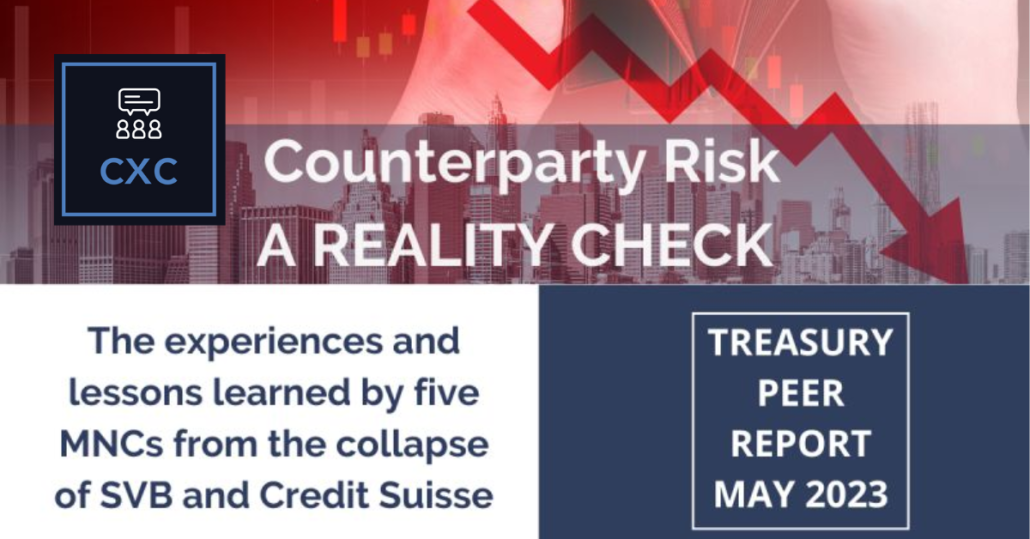Counterparty Risk – A Reality Check
By ComplexCountries
03/07/2023
Risk management. Every treasurer includes this as part of their job description, and we are rightly proud of what we do in this area. But, every now and again, we get a reality check. How good are our processes?

Can’t get enough? Check out these latest items
 https://treasuryxl.com/wp-content/uploads/2025/09/Nomentia-BLOGS-featured-5.png
200
200
treasuryXL
https://treasuryxl.com/wp-content/uploads/2018/07/treasuryXL-logo-300x56.png
treasuryXL2025-12-12 12:54:092025-12-12 13:07:57Nomentia Announces Leadership Transition to Drive Next Phase of Growth
https://treasuryxl.com/wp-content/uploads/2025/09/Nomentia-BLOGS-featured-5.png
200
200
treasuryXL
https://treasuryxl.com/wp-content/uploads/2018/07/treasuryXL-logo-300x56.png
treasuryXL2025-12-12 12:54:092025-12-12 13:07:57Nomentia Announces Leadership Transition to Drive Next Phase of Growth https://treasuryxl.com/wp-content/uploads/2023/03/Treasurer-Search-Logo.png
200
200
treasuryXL
https://treasuryxl.com/wp-content/uploads/2018/07/treasuryXL-logo-300x56.png
treasuryXL2025-12-11 14:07:112025-12-11 14:09:21Sales Director Investments @ Treasurer Search
https://treasuryxl.com/wp-content/uploads/2023/03/Treasurer-Search-Logo.png
200
200
treasuryXL
https://treasuryxl.com/wp-content/uploads/2018/07/treasuryXL-logo-300x56.png
treasuryXL2025-12-11 14:07:112025-12-11 14:09:21Sales Director Investments @ Treasurer Search https://treasuryxl.com/wp-content/uploads/2025/12/HSBC.png
200
200
treasuryXL
https://treasuryxl.com/wp-content/uploads/2018/07/treasuryXL-logo-300x56.png
treasuryXL2025-12-11 14:02:562025-12-11 14:02:56Middle Office Assistant – Trade Finance @ HSBC
https://treasuryxl.com/wp-content/uploads/2025/12/HSBC.png
200
200
treasuryXL
https://treasuryxl.com/wp-content/uploads/2018/07/treasuryXL-logo-300x56.png
treasuryXL2025-12-11 14:02:562025-12-11 14:02:56Middle Office Assistant – Trade Finance @ HSBC https://treasuryxl.com/wp-content/uploads/2024/01/Template_VACANCY-featured.png
200
200
treasuryXL
https://treasuryxl.com/wp-content/uploads/2018/07/treasuryXL-logo-300x56.png
treasuryXL2025-12-11 13:48:452025-12-11 17:05:04Vacature Sales Director Investments – Klantengroep Large Corporates
https://treasuryxl.com/wp-content/uploads/2024/01/Template_VACANCY-featured.png
200
200
treasuryXL
https://treasuryxl.com/wp-content/uploads/2018/07/treasuryXL-logo-300x56.png
treasuryXL2025-12-11 13:48:452025-12-11 17:05:04Vacature Sales Director Investments – Klantengroep Large Corporates https://treasuryxl.com/wp-content/uploads/2025/11/FinanceKey-Featured.png
200
200
treasuryXL
https://treasuryxl.com/wp-content/uploads/2018/07/treasuryXL-logo-300x56.png
treasuryXL2025-12-11 07:00:242025-12-11 09:16:42How to Design a Treasury Technology Roadmap
https://treasuryxl.com/wp-content/uploads/2025/11/FinanceKey-Featured.png
200
200
treasuryXL
https://treasuryxl.com/wp-content/uploads/2018/07/treasuryXL-logo-300x56.png
treasuryXL2025-12-11 07:00:242025-12-11 09:16:42How to Design a Treasury Technology Roadmap https://treasuryxl.com/wp-content/uploads/2025/08/Blog-Kyriba-7.png
200
200
treasuryXL
https://treasuryxl.com/wp-content/uploads/2018/07/treasuryXL-logo-300x56.png
treasuryXL2025-12-10 07:00:092025-12-09 16:38:22Does your company need a Head of Working Capital (and why nobody seems to have one)?
https://treasuryxl.com/wp-content/uploads/2025/08/Blog-Kyriba-7.png
200
200
treasuryXL
https://treasuryxl.com/wp-content/uploads/2018/07/treasuryXL-logo-300x56.png
treasuryXL2025-12-10 07:00:092025-12-09 16:38:22Does your company need a Head of Working Capital (and why nobody seems to have one)? https://treasuryxl.com/wp-content/uploads/2024/08/Surecomp-BLOGS-featured-3.png
200
200
treasuryXL
https://treasuryxl.com/wp-content/uploads/2018/07/treasuryXL-logo-300x56.png
treasuryXL2025-12-09 07:00:012025-12-08 16:15:18Trade Finance in the Nordics: What Scandinavian corporates really want in 2026
https://treasuryxl.com/wp-content/uploads/2024/08/Surecomp-BLOGS-featured-3.png
200
200
treasuryXL
https://treasuryxl.com/wp-content/uploads/2018/07/treasuryXL-logo-300x56.png
treasuryXL2025-12-09 07:00:012025-12-08 16:15:18Trade Finance in the Nordics: What Scandinavian corporates really want in 2026 https://treasuryxl.com/wp-content/uploads/2025/12/TreasurySpring-van-Template-4.png
200
200
treasuryXL
https://treasuryxl.com/wp-content/uploads/2018/07/treasuryXL-logo-300x56.png
treasuryXL2025-12-08 08:39:122025-12-08 08:39:12Odds of cuts being cut!
https://treasuryxl.com/wp-content/uploads/2025/12/TreasurySpring-van-Template-4.png
200
200
treasuryXL
https://treasuryxl.com/wp-content/uploads/2018/07/treasuryXL-logo-300x56.png
treasuryXL2025-12-08 08:39:122025-12-08 08:39:12Odds of cuts being cut! https://treasuryxl.com/wp-content/uploads/2023/03/Treasurer-Search-Logo.png
200
200
treasuryXL
https://treasuryxl.com/wp-content/uploads/2018/07/treasuryXL-logo-300x56.png
treasuryXL2025-12-05 10:45:072025-12-05 10:45:07Senior Manager Treasury – Utrecht Region @ Treasurer Search
https://treasuryxl.com/wp-content/uploads/2023/03/Treasurer-Search-Logo.png
200
200
treasuryXL
https://treasuryxl.com/wp-content/uploads/2018/07/treasuryXL-logo-300x56.png
treasuryXL2025-12-05 10:45:072025-12-05 10:45:07Senior Manager Treasury – Utrecht Region @ Treasurer Search



Recent events have provided just such a check, with the failure of Silicon Valley Bank (SVB) in the US, and Credit Suisse. This call was a “lessons learned” session, with an excellent and very detailed discussion on the operational aspects of what people went through, together with some of the broader issues, including the, very human, tendency not to take risks seriously until they materialise.
The call took place before the failure of First Republic Bank, and its acquisition by JPMorgan.
This summary is two pages long – this was a very detailed call, with a lot of practical learning and experience sharing.
So I will put the bottom line before the long read: the participants who had problems with the collapse of SVB did so because they had delayed integrating recent acquisitions into their normal counterparty risk management processes. With acquisitions, there are good reasons for doing this – but also risks. Others felt management was losing sight of these issues – so it was a useful wake-up call. All participants were grateful to their centralised processes, which meant they could get the information on the exposure quickly, even if this required working with other, centralised, functions. All participants are moving away from using smaller regional or local banks, wherever possible.
It can be hard to justify having a proper and rigorous counterparty risk management process, especially when it has been a few years since the last significant bank failure. This was an important wake-up call. Fortunately, it came at no cost.
Operational issues:
Counterparty Risk Management:
This report was produced by Monie Lindsey, based on a Treasury Per call chaired by Damian Glendinning.
To access this report
Access to the full report is available to Premium Subscribers of ComplexCountries. Please log in on the website of ComplexCountries to access the download.
Please contact ComplexCountries to find out about their subscription packages.